Keyword
raw material
130 record(s)
Provided by
Type of resources
Available actions
Topics
Keywords
Contact for the resource
Service types
-
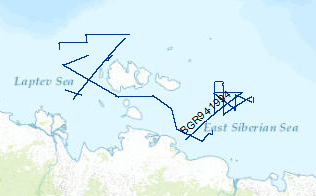
On the M/V Akademic Nemchinow multichannel seismic measurements were carried out on 34 lines with a total length of 4,000 km. The area covered was the Laptev Sea. The data format is Society of Exploration Geophysicists SEG Y.
-
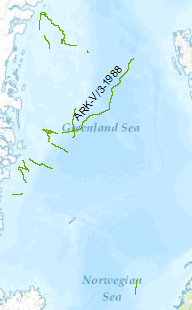
In July/August 1988 a seismic reconnaisance survey was carried out with F.S. Polarstern on the perennially ice covered East Greenland shelf between latitudes 73°N and 81°N. The data format is Society of Exploration Geophysicists SEG Y. 14 reflection seismic lines with a total length of 2.016 km and 12 sonobuoy refraction profiles were recorded. The following results were obtained: •On the wide Holm Land shelf province north of 79°N three possible Cretaceous rift basins were observed. •A buildup of layered extrusive basaltic rocks forming a wedge of seaward dipping reflectors underlies the Holm Land continental slope. •On the Northeastern Greenland shelf province the existence of a wide sedimentary basin was demonstrated north of 76°N. •South of 76°N four volcanic structures from the continent to ocean were observed: The zone of Early Tertiary plateau basalts (zone I) that occur landward of an escarpment, a flat lying basaltic flow unit immediately seaward of the escarpment (zone II), an elongate wedge of seaward dipping reflectors (zone IIIa), a basaltic flow unit which in places shows seaward dipping beds of short length (zone IIIb), and the oceanic crust. •Dyke swarms and intrusions of inferred Neogene age were recognized at several locations.
-
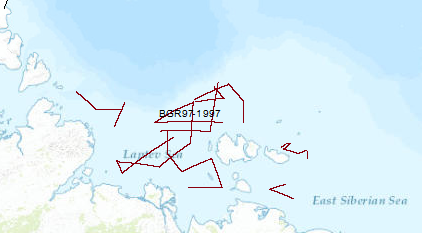
The 3rd cooperative BGR/SMNG Arctic cruise was designed to acquire new scietific data for a better understanding of temporal and spatial lithospheric variations during rifting and its influence on the tectonic and structural evolution of the continental crust of the Laptev Sea undergoing extension since at least the Early Tertiary, and for tackling open questions regarding the evolution of the submarine permafrost zone. Although conditions for seismic measurements were worse in 1997 than in 1993 and 1994, along 4,622 km of seismic traverses reflection seismic data and wide angle reflection/refraction data from 23 OBH-(ocean bottom hydrophone) stations were collected in the Laptev and East Siberian Sea. The most prominent rift basin is the Ust' Lena Rift, which is at least 300 km wide at latitude 75°N. The Cenozoic sedimentary cover exceeds 3 km everywhere, increasing up to 14 km at two locations. In the northern part of the shelf, the complex mainly N–S-trending Anisin Basin has a basin fill of up to 10 km thickness. The New Siberian Basin which is located in the northwestern part of the study area shows an up to 9 km thick graben fill. The Laptev Horst crust is locally subdivided into several tilted blocks by deep-reaching faults and there are several half grabens of smaller extent which divide the Laptev Horst into three parts: the North, the South and the East Laptev Horst. A major west dipping listric fault of at least 250 km length separates the Laptev Horst from the Ust' Lena Rift. Results from the seismological investigation indicate that recent extension is concentrated within the narrow rift basins of the eastern Laptev Sea. From wide-angle reflection/refraction seismic measurements the seismic velocities of the crustal layers were estimated along five profiles. The layers with velocities of up to 3.5 km/s apparently consist of predominantly Cenozoic sediments. The sedimentary section showing relatively high seismic velocities of 4.5 to 5.2 km/s might be interpreted as Late Paleozoic to Mesozoic deposits or overcompacted/cemented syn-rift deposits. In the eastern shelf area a layer beneath the acoustic basement was interpreted to represent Ordovician to Early Mesozoic carbonates. The lower crust in the area under study shows relatively uniform seismic velocities of about 6.0-6.8 km/s and the velocities estimated for the crust-mantle transition are in the range of 8.0 to 8.2 km/s. The origin of a several 100 m thick layer with a relative high velocity of 3 to 3.5 km/s directly beneath the seafloor was inferred as sub-sea permafrost.
-

The major pre-alpine tectonic lineaments as the Glückstadt Graben and the Avalonia-Baltica suture zone run across the southern Baltic. The BalTec expedition aimed at the gapless imaging of these fault systems from the seafloor down to the Paleozoic basement. Scientifically the expedition was motivated by two hypotheses. We postulated that advances and retreats of icesheets during the glacials initiated and reactivated faulting of the Post-Permian succession, thereby generating several kilometers long near-vertical faults and anticlines. We further postulated that – in contrast to the generally accepted text book models – deformation of the initially up to 1800 m thick Zechstein salt started already during salt deposition as the consequence of salt load induced basin subsidence and resulting salt creep. The profile network was further designed to allow for linking the stratigraphy between previously generated local underground models in the frame of the TUNB project. Altogether we collected during cruise MSM52 onboard of R/V Maria S. Merian 62 reflection seismic profiles of an entire length of 3500 km. This data set contains all seismic lines located in the German EEZ (lines BGR16-212 to BGR16-264) as time-migrated version.
-
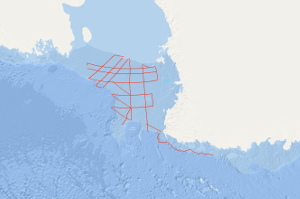
During the cruise with S.V. EXPLORA within the Ross Sea on the second marine-geophysical expedition of the Federal Institute for Geosciences and Natural Resources (BGR) to Antarctica, in total 6,745 km of magnetic, gravity and digital reflection seismic lines and additionally 1,400 km gravity lines were acquired in the period from January 10th to March 2nd 1980. On 43 stations sonobuoy refraction measurements have been carried out. The main results are: (1) In the eastern part of the Ross Sea Shelf two striking discontinuities have been identified in the reflection seismics representing gaps in the sediments at the turn-over of the Upper Miocene to the Pliocene (ca. 7 mio years B.P.) and between the Middle and Upper Miocene (ca. 11.5 mio. years B.P.) according to results of DSDP boreholes. (2) In the southern part of the Ross Sea Shelf the basement is uncovered at depths over 700m due to a thrust of the shelf ice recently. (3) A structural unit extends alongside the meridian of 180° separating the Ross Sea into two different geologic regions. This unit is characterised by two basement highs with seismic velocities exceeding 5 km/sec. (4) In relation with the GANOVEX expedition two profiles have been measured off northern Victoria Land which indicate two large faults with a faulting amount of 2 km. Another area is characterised by intrusive and volcanic bodies.
-

The structure and tectonics of the Pacific margin of Costa Rica were studied by multichannel seismic measurements in parallel with gravity measurements and swathmapping from the Cocos Ridge to Nicoya Peninsula during R/V SONNE cruise SO81 legs 1 and 2 from 18th August to 15th September 1992. In addition geological sampling has been carried out. Dominant structural feature is the buried Costa Rica Terrrane (CRT), a complex and segmented, wedge-shaped unit characterized by relative high seismic velocities of 4 km/s. The thickness of this several tens of kilometres wide zone varies between 0.5 and 3 s (twt). The CRT forms the backstop against which the sediments of the subducting Cocos plate accrete resulting in accumulation of sedimentary mass beneath and in front of the CRT, as well as in simultaneous uplift and fracturing of the CRT. It appears that the distinct CRT is affected locally by raft tectonics, i.e. a form of thin-skinned extension by normal faulting from gravity sliding over a non-stretched oceanic crust. A unit is recognizable between the base of the CRT and the surface of the subducting oceanic crust on most of the seismic lines. This unit is thought to consist mostly of ductile pelagic to hemipelagic shales. Some segment boundaries of the CRT are associated with morphological furrows, 5 to 10 km wide and up to 30 km long running across the slope. We feel that the data acquired during SONNE cruise SO81, and the preliminary results at hand have already improved our knowledge on the geological processes of active continental margins. We are convinced that plausible concepts for the origin of tsunamis and asperities can be developed on the basis of the data collected during SONNE cruises SO81 and SO76. The research of both SONNE cruises are a contribution to the International Decade of Natural Desaster Reduction (IPNDR).
-
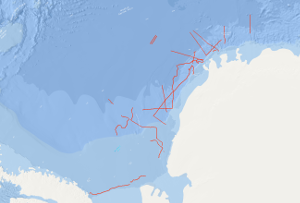
On the F.S. POLARSTERN cruise ANT-IV/3 (6th December, 1985 - 13th March, 1986) multichannel seismic measurements were carried out in parallel with magnetic and gravimetric measurements on 33 lines with a total length of 6,263 km. 3,350 km of the multichannel seismic lines have been processed aboard. The geophysical studies were designed to investigate the structure and geological development of the Weddell Sea continental margin from meridians zero to 60°W, and to define suitable and safe drilling locations for Leg 113 of the Ocean Drilling Program. The main results of the geophysical studies are: (1) The discovery of an approximately N50°E trending failed drift basin, following the trend of a negative magnetic anomaly and a positive gravity anomaly. (2) The discovery of two extensive wedge-shaped and symmetric basement units around a failed drift basin between longitudes 40°W and 20°W. The seismic characteristics, i.e. seismic velocities of 4 km/s and an internally divergent pattern of reflectors suggest that both wedges are formed from extrusive/intrusive volcanic rocks. (3) The confirmation of a major plate tectonic boundary trending approximately N80°E to N60°E, i.e. the EXPLORA-ANDENES escarpment. (4) The confirmation of a glaciogenic progradational wedge beneath the shelf of the Weddell Sea Embayment, made up of several thousand metres of sediments. (5) The definition of 13 suitable and safe drilling locations for ODP-Leg 113.
-

The multidisciplinary marine geoscientific expedition ARK-25/3 was focused on the Greenland part of northern Baffin Bay and was aimed to acquire new geoscientific data to be used for modelling the evolution of the Greenland continental margin and its hydrocarbon prospective. The data format is Society of Exploration Geophysicists SEG Y. The cruise was performed under the direction of the Federal Institute for Geosciences and Natural Resources Hannover in cooperation with the Alfred-Wegener-Institute for Polar and Marine Research, Bremerhaven. Using 70 days of ship time onboard the research icebreaker R/V POLARSTERN a comprehensive data set was acquired along profiles extending from the deep oceanic basin in the central part of North Baffin Bay onto the Greenland continental margin in an area which was bordered by the Kane Basin in the North and Disko Island in the South. By means of multi-channel seismic, wide angle seismic, gravimetric and magnetic methods the structural inventory of the crust in the NW Baffin Bay was investigated. Additionally, heat flow data and sediment cores were collected along lines crossing the Greenland continental margin. The cores were extracted for geochemical and geomicrobiological analysis to be used for basin modelling, studying the hydrocarbon potential, and the hydrocarbon degradation by microorganisms under polar conditions. Geological sampling in the coastal area was done between Melville Bay and Washington Land. The collected rock material will be used to derive constraints on the erosion history of the coastal area. Aeromagnetic data was acquired covering a substantial part of the marine survey area to investigate magnetic signatures of the oceanic crust and the continental margin. This report summarizes the working programme and contains the documentation of acquired data and first results of the expedition.
-

In September 1993, the Federal Institute for Geoscience and Natural Resources (BGR) has carried out in cooperation with Sevmorneftegeofizika (SMNG), Murmansk a 2D-seismic survey of the eastern part of the Laptev Sea shelf. The data format is Society of Exploration Geophysicists SEG Y. During the survey with a total length of 3189 km the 70 km wide New Siberian Basin and two other basins were mapped. In the central part of the New Siberian Basin, a Tertiary sediment thickness of more than 4 km overlying older sediments was observed. Further to the east, a large area covered by lava flows of unknown thickness was investigated. There are no indications of a propagation of real seafloor spreading into the Laptev Shelf and thus the Asian continental crust. Therefore seafloor spreading seems impossible at total spreading rates below 0.7 cm/year, at least for crust of the character which is present here.
-
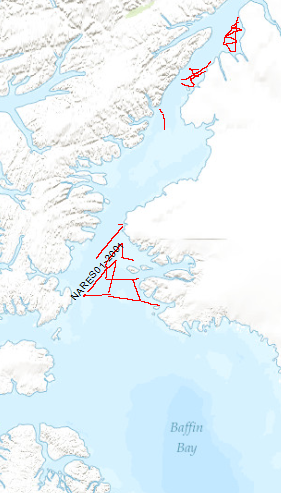
The Scientific staff and crew onboard CCGS Louis S. St. Laurent (LSL) returned September the 10th, 2001 from a scientific expedition to the Nares Strait, the northernmost waterway connecting the Arctic and Atlantic oceans. The data format is Society of Exploration Geophysicists SEG Y. The ice conditions in the strait required the support of Canada's largest ice breaker. The ship was a versatile platform for 34 scientists to accomplish their marine investigation. The LSL has a history of supporting international scientific expeditions including an oceanographic transect of the Arctic Ocean in 1994 and a biological study of the Canadian Arctic Islands in 1999. Germany (Bundesanstalt für Geowissenschaften und Rohstoffe, BGR) and Canada (Geological Survey of Canada) undertook a 5-week scientific cruise to study and explore the geological structure and evolution of the Nares Strait. The primary objective was the study of structural features relating to the formation of the Arctic Ocean and, in particular, the study of the Wegener Fault. This fault is a linear boundary between Greenland and Ellesmere Island which was noted by the German scientist Alfred Wegener in 1915 and later became the subject of a major scientific controversy. The co-operative cruise, which was planned over a period of 2 years, provided the basis for a wide range of scientific investigations, from marine seismic work and climate change studies through airborne magnetic investigations to geodetic survey measurements and geological sampling onshore. Systematic geophysical offshore studies in this key area had not been undertaken before. Where towing of seismic equipment was not possible because of ice coverage, magnetic maps were made using a helicopter-borne magnetic sensor system. Sediment and water samples taken during the cruise provide information on changes in climate and sea ice cover from the last ice-age to the present. An 11 m-long sediment core from outer Jones Sound is the longest core ever taken in the Canadian Arctic channels and holds clues to the detailed climate history of northern Baffin Bay.
 www.geodatenkatalog.de (S2F)
www.geodatenkatalog.de (S2F)